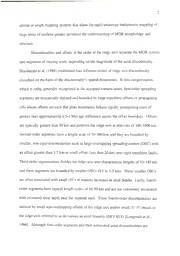
Geochemistry of Eastern Pacific Morb: implications for morb petrogenesis and the nature of crustal accretion within the neovolcanic zone of two recently active ridge segments PDF
Preview Geochemistry of Eastern Pacific Morb: implications for morb petrogenesis and the nature of crustal accretion within the neovolcanic zone of two recently active ridge segments
GEOCHEMISTRYOFEASTERNPACIFICMORE: IMPLICATIONSFORMOREPETROGENESISANDTHENATUREOFCRUSTAL ACCRETIONWITHINTHENEOVOLCANICZONEOFTWORECENTLYACTIVE RIDGESEGMENTS By MATTHEWC.SMITH ADISSERTATIONPRESENTEDTOTHEGRADUATESCHOOL OFTHEUNIVERSITYOFFLORIDAINPARTIALFULFILLMENT OFTHEREQUIREMENTSFORTHEDEGREEOF DOCTOROFPHILOSOPHY UNIVERSITYOFFLORIDA 1999 ACKNOWLEDGMENTS Therearemanythathavecontributedtothisresearchanddeserve aclcnowledgement. IwouldliketothankDr.MichaelPerfitforhelpingtoputmeina positiontotakeadvantageofnumerousopportunitiestoparticipateonthefascinating oceanographiccruisesthathaveledtothisresearch. Withouthiscontacts,guidance, mentorship,andfriendship,noneofthiswouldhavebeenpossible. Drs.RobertEmbley andDanielFomariservedaschiefscientistsonmanyofthecruisestotheJuandeFuca andEastPacificRiserespectively. Theirexampleofhowtobeaneffectiveseagoing scientistmadealastingimpressiononme,andthisresearchbenefitedfrommany discussionsofthestructureandvolcanicmorphologyofeasternPacificspreadingcenters. ThecrewsoftheALVIN,AtlantisII,ROPOSandDiscovererdeservethanksfortheir willingnesstopursuetheexcellencewerequired,evenintheweehoursofthemorning. Dr.WilliamChadwickgraciouslypreparedthesamplelocationmapsinchapter2and providedAMS-60datatoaidininterpretationofregionalgeologicassociations. H.Paul Johnsongenerouslydonatedsplitsofbasaltsamplescollectedduringthreecruisestothe CoAxialSegment. Dr.AnnHeatheringtonassistedgreatlyintheisotopicanalysesandI thankher. Drs.TimO'HeamandW.I.RidleyanalyzeddatafromtheSmithsonianand USGSrespectively,andDr.IanJonassonprovidedICPdatafromtheGSCatnocostto thisproject. Iowethemalladebtofgratitude. Dr.KarenVonDamm,Dr.JohnLupton andDr.MarvinLilleygraciouslyprovidedunpublisheddataforventfluidsdiscussedin chapter3. D.JohnChadwickalsograciouslyprovidedhisunpublisheddataforbasalts ii fromAxialSeamountsouthriftzoneusedinchapter2discussions. Lastly,Iwouldlike tothankRobinMilamforherassistanceintheformattingandpreparationofthis manuscript,andmyfamilyfortheircontinualloveandsupport. iii 11 TABLEOFCONTENTS page ACKNOWLEDGMENTS ii ABSTRACT vi CHAPTERS GENERALINTRODUCTION 1. 1 1.1 TheCoAxialSegment 7 1.2 TheEastPacificRisebetween9and10°N 8 2. GEOCHEMICALCHARACTERISTICSANDPETROGENETIC RELATIONSHIPSOFRECENTLYERUPTEDMOREFROMTHE CENTRALJUANDEFUCARIDGE: SEGMENTSCALE, INTERFLOWANDINTRAFLOWVARIATIONS 11 2.1. Introduction 11 2.1.1 FieldInvestigationsandPreviousStudies 1 2.1.2 RegionalGeology 12 2.2. DataCollectionandSampleDistribution 16 2.2.1 AlvinandROVBasedSampleAcquisition 16 2.2.2 SurfaceBasedSampleAcquisition 16 2.2.3 SidescanSonarandNearBottomPhotographicDataAcquisition 20 2.3. AnalyticalMethods 20 2.3.1 SamplePreparation 20 2.3.2 MajorElementAnalyses 22 2.3.3 TraceElementAnalyses 26 2.3.4. IsotopicAnalyses 33 2.4. RegionalCoAxialSegmentGeochemicalCharacteristics 33 2.4.1 MajorElementTrends 33 2.4.2 IsotopicandTraceElementSignals 40 2.5.DiscriminationofDiscreteFlowUnits 46 2.5.1 VisualandBathymetricFlowDiscrimination 46 2.5.2 GeochemicalFlowDiscrimination 48 2.6. DistinctionofRegionalPetrochemicalProvinces 61 2.6.1 AxialSeamountProvince 62 2.6.2 TheWesternFaultBlockRidge 70 2.6.3 SmallNRZVolcanoes 7 iv 1 2.6.4TheCoAxialSegment 73 2.7. Discussion 74 2.7.1 RecentCoAxialSegmentVolcanism 74 2.7.2 Intra-flowGeochemicalVariability 78 2.7.3 RegionalPetrochemicalCharacteristics 81 2.7.4 RegionalMantleHeterogeneityandtheOriginsofCoAxial SegmentGeochemicalDepletion 85 2.8.Conclusions 87 3. SUBMARINEINVESTIGATIONSOFATHIRD-ORDEROSCA9°37'N: ESTABLISHINGACAUSEANDEFFECTRELATIONSHIPBETWEENOSC PROPAGATIONANDMAGMATICACTIVITY 89 3.1. Introduction 89 3.2. PreviousStudiesandRegionalGeology 91 3.2.1 PreviousStudies 91 3.2.2 GeneralSecond-OrderScaleObservations 99 3.2.3 PreviousGeologicObservationsoftheEPRAxisBetween9° 49.9'Nand9°37.1'N 102 3.3. DataAcquisitionandAlvinObservations 104 3.3.1 InSituGeologicObservations 104 3.3.2 HydrothermalandBiologicActivity 109 3.4. BasaltGeochemistry 11 3.4.1 BasaltSampleRecoveryandAnalysisProcedures Ill 3.4.2 Second-OrderSegmentScaleGeochemicalObservations 118 3.4.3 Fourth-OrderSegmentScaleGeochemicalObservationsof SegmentD 130 3.5. Discussion 131 3.5.1 SouthwardAgingofVolcanicActivity 131 3.5.2 The9°37'OSCasaMagmaticandHydrothermalDivide 133 3.5.3 EvidenceforaMagmaticPerturbationat9°37' 136 3.5.4 AssociationofE-TypeMORB 138 3.6. Conclusions 144 4. CONCLUSIONS 147 APPENDIX FREQUENTLYUSEDACRONYMSANDDESCRIPTIONSOF SAMPLINGTECHNIQUES 151 REFERENCES I53 BIOGRAPHICALSKETCH 164 V AbstractofDissertationPresentedtotheGraduateSchool oftheUniversityofFloridainPartialFulfillmentofthe RequirementsfortheDoctorofPhilosophy GEOCHEMISTRYOFEASTERNPACIFICMORE: IMPLICATIONSFORMOREPETROGENESISANDTHENATUREOFCRUSTAL ACCRETIONWITHINTHENEOVOLCANICZONEOFTWORECENTLYACTIVE RIDGESEGMENTS By MatthewC.Smith December1999 Chairman:MichaelR.Perfit MajorDepartment:GeologicalSciences Adetailedinvestigationoftworecentlyvolcanicallyactivemid-oceanridge (MOR)segmentsintheN.E.PacificOceanhasresultedinabetterunderstandingof crustalaccretionwithintheneovolcaniczonesofmedium-tofast-spreadingridges. The useofsubmersibleandothernear-bottomsystems,inconjunctionwithrocksamplingby waxcore,providesexcellentspatialcontrol,resultinginadatabaseofpreciselylocatedin situgeologicobservationsandsamples. Thecombinationofdensehigh-resolution sampling,temporalcontrolgainedbyrecenteruptiveactivity,andmulti-yearmonitoring effortsmakestheseinvestigationsuniqueinMORresearch. TheCoAxialSegmentoftheJuandeFucaRidge(JdFR)isamedium-spreading rateridgethathasexperiencedatleastthreevolcaniceruptionsbetween1981and1993. Evidenceofamagmaticextensionandchemicalheterogeneitybetweendifferentlava flowsindicatesthattheCoAxialSegmenthasbehavedasamagmalimitedsystem, despitetheoccurrenceofrecenteruptiveactivity. ThecurrentCoAxialSegment neovolcaniczoneisgreaterthan1kmwide,andspatialfocussingoferuptiveactivityis vi poorrelativetothemoremagmaticallyrobustCleftSegmentoftheJdFRand9-10N segmentoftheEastPacificRise(EPR). AbroadersurveyofthecentralJdFRreveals that,onaregionalscale,geochemicallydifferentmeltregimescanbeassociatedwith distinctstructural,morphologicandvolcanicprovinces. Detailedstudyofridge-axismorphology,structure,andchemistryofthefaster spreading,magmaticallyrobust,9°-10°NsegmentoftheEPRshowsadifferent relationshipbetweenridge-axisstructureandmagmaticactivitythanthatobservedatthe CoAxialSegment. Datafromathird-orderoverlappingspreadingcenter(OSC)located at9°37'Nsuggeststhatthereisacloseassociationbetweenmagmaticactivityandaxial discontinuities,andfurthersuggestthatthisOSCisamagmaticandhydrothermaldivide betweenadjoiningthird-orderridgesegments. Temporalconstraintscorrelatearecent magmaticeventtosouthwardpropagationoftheeasternOSClimb. Thesedataestablish adirectcausalrelationshipbetweenmagmaticactivityandevolutionofridge-axis discontinuities,andconfirmthatsegmentationofmeltdeliverytotheridge-axismay affectridge-axisstructurealongthefastspreadingEPR. vii CHAPTER 1 GENERALINTRODUCTION Themid-oceanridge(MOR)systemisaglobe-encirclingvolcanicmountain chainmorethan60,000kmlong. Itextendsthroughoutalloftheworld'smajorocean basins,risingsome1000-3000mabovetheabyssalseafloor. Mid-oceanridgesarethe siteofoceaniccrustalaccretionandlithosphericgenesisand,assuch,areimportanttothe studyofplatetectonicsandEarth'sgeologicalprocesses. Whileanunderstandingof magmaticprocessesoccurringatMORsisanessentialpartofunderstandingplate tectonics,thesignificanceofmagmaticactivityatoceanridgesextendsfarbeyond geologicalinterests. MagmaticactivityalongMORsprovidesthesourceofheatthat drivesextensivehydrothermalcirculationwithintheoceaniccrustwhich,inturn,exertsa stronginfluenceonoceanchemistry. Notonlydoesthisvolcanicallydriven hydrothermalsystemhelptocontrolseawaterchemistry,butitalsoprovidestheenergy thatsupportsarichanddiverseabyssalecosystemthatutilizeschemosyntheticreduction asthebasisofitsfoodweb. Surprisingly,relativelylittleofthisimmensevolcanicsystemhasbeenstudiedin detail. Difficultiesininvestigatingsucharemoteandextremeenvironmentlimiteddirect examinationuntilthe1960'swhenadvancesintechnologyallowedmantotraveltoand freelyaccessthemid-oceanridges,whichtypicallyrangefrom2000-4000metersbelow sealevel. EarlystudiessampledtheMORsystemwithcoarsespatialresolution, providinginsightsonsomeofthefirst-orderdifferencesbetweendifferentridges. The 1 2 adventofswathmappingsystemsthatallowforrapidunderwaybathymetricmappingof largeareasofseafloorgreatlyadvancedtheunderstandingofMORmorphologyand structure. Discontinuitiesandoffsetsinthestrikeoftheridge-axisseparatetheMORsystem intosegmentsofvaryingscale,dependingonthemagnitudeoftheaxialdiscontinuity. Macdonaldetal.(1988)establishedfourdifferentordersofridgeaxisdiscontinuity classifiedonthebasisofthediscontinuity'sspatialdimensions. Inthiscategorization, whichistodaygenerallyrecognizedastheacceptednomenclature,first-orderspreading segmentsaretectonicallydefinedandboundedbylargetransformoffsetsorpropagating riftswhoseoffsetsaresuchthatplateboundariesbehaverigidly,juxtaposingcrustof greaterthanapproximately0.5-1Myragedifferenceacrosstheoffsetboundary. Offsets aretypicallygreaterthan50kmandpartitiontheridge-axisatintervalsof100-1000km. Second-ordersegmentshavealengthscaleof50-300km,andtheyareboundedby smaller,non-rigiddiscontinuitiessuchaslargeoverlappingspreadingcenters(OSC)with anoffsetgreaterthan3-5kmorsmalloffset(lessthan20km)non-rigidtransformfaults. Third-ordersegmentationdividestheridge-axisintocharacteristiclengthsof30-100km, andthesesegmentsareboundedbysmallerOSCs(0.5to3-5km). ThesesmallerOSCs areoftenassociatedwithsmall(lO'sofmeters)increasesinaxialdepths. Lastly,fourth- ordersegmentshavetypicallengthscalesof10-50kmandarenotcommonlyassociated withincreasedaxialdepthnearthesegmentends. Thesefourth-orderdiscontinuitiesare definedbysmallnon-overlappingoffsetsoftheridgeaxisand/orsmall(r-5°)bendsin theridge-axisreferredtoasdeviationsinaxiallinearity(DEVALS)[Langmuiretal., 1986]. Althoughfirst-ordersegmentsandtheirassociatedaxialdiscontinuitiesare 3 thoughttobepersistentontheorderofmilhonsofyears,smallerridgeoffsetsmaynotbe astemporallystable[Macdonaldetal.,1988b]. AsinvestigationsoftheMORsystemwereundertakenatfinerandfinerspatial scales,itbecameapparentthatthemid-oceanridgeenvironmentwastheproductof complexinteractionsbetweenmagmatic,tectonic,hydrologic,andbiologicprocesses. Onlybycompilingdetailedinvestigationsofprocessesoccurringatdifferentspreading segmentswouldamorecomprehensiveunderstandingofthisenvironmentbeachieved. Todate,onlyasmallpercentageofthemid-oceanridgesystemhasbeensubjectedto detailedmulti-disciplinaryinvestigationatthefirsttofourth-ordersegmentscale. Oceanicridgesexhibitarangeofplatedivergenceor"spreadingrates". Full divergenceratesvarybyoveranorderofmagnitude,andtoafirst-approximationridge morphology,structure,andmagmaticactivityarestronglyinfluencedbythisspreading rate[PerfitandChadwick,1998]. Typically,slow-spreadingridges(fullplate-divergence rateontheorderof1-4cm/year),exemplifiedbyridgesintheAtlanticandIndianoceans, risesteeplyfromtheabyssrelativetofaster-spreadingMORs. Theyaregenerallyrifted byanaxialgrabenthatcanbelO'sofkilometersacrossandgreaterthan1500metersin relief. Slow-spreadingridgeterrainsaregenerallymoregreatlyaffectedbyextensional tectonicsandfaultingand,assuch,tendtobemuchrougherthanatfaster-spreading ridges. Volcanicmorphologyoftheaxisfloor,whichisthesiteofactivecrustal accretion,tendstobedominatedbydiscreteconstructionalfeaturesthatmaycoalesceto formmoundsorridges. Lavamorphologyisoftenpillowed,acharacteristicassociated withrelativelyslowlavaeffusiverates. Thezoneofcrustalaccretion,or"neovolcanic zone,"isthoughttoberelativelywideandunfocussed(2-12kmwide),withrelatively
